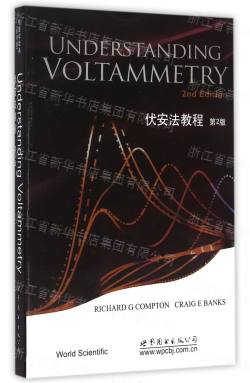-
内容大纲
伏安法是最基本的测量电阻的手段,也是电分析化学中最基本及简单的检测手段之一,在科学研究和生产实践中有广泛的应用。卡普顿编著的《伏安法教程(第2版)》作为一本教材,详细地介绍了各种伏安法实验的设计和应用,并对伏安法中可能遇到的难点给出了严谨的解决方案。本书第一版系畅销教材,第二版在第一版的基础上增加了两章,以便读者更好的学习、理解。这套教材和习题,原版十分畅销,中科院长春应化所的彭章泉博士曾写信给作者,觉得此书非常好,拜读了10遍以上。中科院的万立俊研究员认为此书非常好,是物理化学领域的高端图书。 -
作者介绍
-
目录
Preface
1 Equilibrium Electrochemistry and the Nernst Equation
1.1 Chemical Equilibrium
1.2 Electrochemical Equilibrium: Introduction
1.3 Electrochemical Equilibrium: Electron Transfer at the
Solution-Electrode Interface
1.4 Electrochemical Equilibrium: The Nernst Equation
1.5 Walther Hermann Nernst
1.6 Reference Electrodes and the Measurement of Electrode Potentials
1.7 The Hydrogen Electrode as a Reference Electrode
1.8 Standard Electrode Potentials and Formal Potentials
1.9 Formal Potentials and Experimental Voltammetry
1.10 Electrode Processes: Kinetics vs. Thermodynamics
2 Electrode Kinetics
2.1 Currents and Reaction Fluxes
2.2 Studying Electrode Kinetics Requires Three Electrodes
2.3 Butler-Volmer Kinetics
2.4 Standard Electrochemical Rate Constants and Formal Potentials
2.5 The Need for Supporting Electrolyte
2.6 The Tafel Law
2.7 Julius Tafel
2.8 Multistep Electron Transfer Processes
2.9 Tafel Analysis and the Hydrogen Evolution Reaction
2.10 B. StanleyPons
2.11 Cold Fusion -- The Musical!
2.12 Why Are Some Standard Electrochemical Rate Constants Large
but Others Slow? The Marcus Theory of Electron Transfer: An
Introduction
2.13 Marcus Theory: Taking it Further. Inner and Outer Sphere
Electron Transfer
2.14 Marcus Theory: Taking it Further. Adiabatic and Non-Adiabatic
Reactions
2.15 Marcus Theory: Taking it Further. Calculating the Gibbs Energy
of Activation
2.16 Relationship between Marcus Theory and Butler-Volmer Kinetics
2.17 Marcus Theory and Experiment. Success!
3 Diffusion
3.1 Fick's 1st Law of Diffusion
3.2 Fick's 2nd Law of Diffusion
3.3 The Molecular Basis of Fick's Laws
3.4 How Did Fick Discover His Laws?
3.5 The Cottrell Equation: Solving Fick's 2nd Law
3.6 The Cottrell Problem: The Case of Unequal Diffusion Coefficients
3.7 The Nernst Diffusion Layer
3.8 Mass Transfer vs. Electrode Kinetics: Steady-State
Current-Voltage Waveshapes
3.9 Mass Transport Corrected Tafel Relationships
4 Cyclic Voltammetry at Macroelectrodes
4.1 Cyclic Voltammetry: The Experiment
4.2 Cyclic Voltammetry: Solving the Transport Equations
4.3 Cyclic Voltammetry: Reversible and Irreversible Kinetics
4.4 What Dictates 'Reversible' and'Irreversible' Behaviour?
4.5 Reversible and Irreversible Behaviour: The Effect of Voltage Scan
Rate
4.6 Reversible versus Irreversible Voltammetry: A Summary
4.7 The Measurement of Cyclic Voltammograms: Three Practical
Considerations
4.8 The Effect of Unequal Diffusion Coefficients, DA ~- D8
4.9 Multiple Electron Transfer: Reversible Electrode Kinetics
4.10 Multiple Electron Transfer: Irreversible Electrode Kinetics
4.11 The Influence of pH on Cyclic Voltammetry
4.12 The Scheme of Squares
4.13 Simultaneous Two-Electron Transfer in Electrode Kinetics? . . .
5 Voltammetry at Microelectrodes
5.1 The Cottrell Equation for a Spherical or Hemispherical Electrode
5.2 Potential Step Transients at Microdisc Electrodes
5.3 Microelectrodes Have Large Current Densities and Fast Response
Times
5.4 Applications of Potential Step Chronoamperometry Using
Microdisc Electrodes
5.5 Double Potential Step Microdisc Chronoamperometry Exploring
the Diffusion Coefficient of Electrogenerated Species
5.6 Cyclic and Linear Sweep Voltammetry Using Microdisc Electrode~
5.7 Steady-State Voltammetry at the Microdisc Electrode
5.8 Microelectrodes versus Macroelectrodes
5.9 Ultrafast Cyclic Voltammetry: Megavolts per Second Scan Rates .
5.10 Ultrasmall Electrodes: Working at the Nanoscale
6 Voltammetry at Heterogeneous Surfaces
6.1 Partially Blocked Electrodes
6.2 Microelectrode Arrays
6.3 Voltammetry at Highly Ordered Pyrolytic Graphite Electrodes..
6.4 Electrochemically Heterogeneous Electrodes
6.5 Electrodes Covered with Porous Films
616 Voltammetric Particle Sizing
6.7 Scanning ElectrochemicaIMicroscopy (SECM)
7 Cyclic Voltammetry: Coupled Homogeneous Kinetics and Adsorption
7.1 Homogeneous Coupled Reactions: Notation and Examples . . .
7.2 Modifying Fick's Second Law to Mlow for Chemical Reaction . .
7.3 Cyclic Voltammetry and the EC Reaction
7.4 How Do the Parameters KI and A Emerge?
7.5 Cyclic Voltammetry and the EC2 Reaction
7.6 Examples of EC and EC2 Processes
7.7 ECE Processes
7.8 ECEversus DISP
7.9 The CE Mechanism
7.10 The ECI (Catalytic) Mechanism
7.11 Adsorption
7.12 Voltammetric Studies of Droplets and Solid Particles
8 Hydrodynamic Electrodes
8.1 Convection
8.2 Modifying Fick's Laws to Allow for Convection
8.3 The Rotating Disc Electrode: An Introduction
8.4 The Rotating Disc Electrode-- Theory
8.5 Osborne Reynolds (1842-1912)
8.6 The Rotating Disc Electrode-- Further Theory
8.7 Chronoamperometry at the Rotating Disc Electrode: An
Illustration of the Value of Simulation
8.8 The Rotating Disc and Coupled Homogeneous Kinetics
8.9 The Channel Electrode: An Introduction
8.10 The Channel Electrode: The Levich Equation Derived
8.11 Channel Flow Cells and Coupled Homogeneous Kinetics
8.12 Chronoamperometry at the Channel Electrode
8.13 The Channel Electrode is not 'Uniformly Accessible' .
8.14 Channel Microelectrodes
8.15 Channel Microband Electrode Arrays for Mechanistic
Electrochemistry
8.16 The High Speed Channel Electrode
8.17 Hydrodynamic Electrodes Based on Impinging iets
8.18 Sonovoltammetry
9 Voltammetry for Electroanalysis
9.1 Potential Step Voltammetric Techniques
9.2 Differential Pulse Voltammetry .
9.3 Square Wave Voltammetry
9.4 Stripping Voltammetry
9.5 Sono-electroanalysis
10 Voltammetry in Weakly Supported Media: Migration and Other Effects
10.1 Potentials and Fields in Fully Supported Voltammetry
10.2 The Distribution of Ions Around a Charged Electrode
10.3 The Electrode-Solution Interface: Beyond the Gouy-Chapman
Theory
10.4 Double Layer Effect on Electrode Kinetics: Frumkin Effects . . .
10.5 A.N. Frumkin ,
10.6 Transport by Diffusion and by Migration
10.7 Measurement of Ion Mobilities
10.8 Liquid Junction Potentials
10.9 Chronoamperometry and Cyclic Voltammetry in Weakly
Supported Media
11 Voltammetry at the Nanoscale
11.1 Transport to Particles Supported on an Electrode
11.2 Nanoparticle Voltammetry: The Transport Changes as the
Electrode Shrinks in Size
11.3 Altered Chemistry at the Nanoscale
Appendix: Simulation of Electrode Processes
A.1 Fick's First and Second Laws
A.2 Boundary Conditions
A.3 Finite Difference Equations
A.4 Backward Implicit Method
A.5 Conclusion
Index
同类热销排行榜
- 故宫日历(公历2017年)(精)26.4
- 时间简史(插图版)18
- 工程数学线性代数(第6版十二五普通高等教育本科国家级规划教材)7.76
- 昆虫记(精)/经典译林8.72
- 数控铣床综合实训教程19.2
- 昆虫记(插图典藏本)(精)11.2
- 化工制图习题集(普通高等教育规划教材)7.2
- 化工制图(普通高等教育规划教材)15.8
- 生命急救技能14
- 时间简史(普及版)(精)15.2
推荐书目
-

孩子你慢慢来/人生三书 华人世界率性犀利的一枝笔,龙应台独家授权《孩子你慢慢来》20周年经典新版。她的《...
-

时间简史(插图版) 相对论、黑洞、弯曲空间……这些词给我们的感觉是艰深、晦涩、难以理解而且与我们的...
-

本质(精) 改革开放40年,恰如一部四部曲的年代大戏。技术突变、产品迭代、产业升级、资本对接...

 [
[
